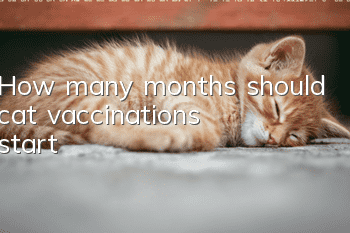What should you pay attention to when raising a cat in spring? Pay attention to preventing cat plague in spring

Feline distemper is a common disease in cats. In recent years, many vaccines have been available to help cats prevent such diseases. However, for newborn kittens or cats without immunity, feline distemper is still very common. Disease, as the temperature gradually rises in spring, cat plague is also ready to attack.
1. Prevention of cat plague in spring
In recent years, the number of cat lovers in our country has gradually increased, especially those who raise purebred cats. The number of friends who raise purebred cats has increased even more rapidly. A large number of cats have been imported into China from abroad, and some of them have entered our country through smuggling channels. There is no quarantine at all, and a considerable number of unhealthy cats come in and seriously threaten domestic cats. This is also the main reason for the frequent occurrence of cat plague in China in recent years.
1. Cat plague is coming
If you find that your cat has a sudden loss of appetite, loose coat, elevated body temperature, vomits yellow-green liquid, diarrhea, sometimes bloody stools, and a foul smell, the owner should be alert at this time. Your cat may have cat plague. Take it to a pet hospital immediately for diagnosis and treatment, and conduct a blood test to determine whether it is feline plague.
2. Fight for cats with cat plague
If detected early, it is still possible to cure feline plague. In addition to maintaining infusion to ensure the energy and electrolyte balance in the cat's body, injecting feline antiviral serum is the main treatment method in China.
3. Shut out the cat plague
Cat plague is indeed terrible, but it is not unpreventable. Feline distemper is mainly transmitted through the digestive tract. The feces, urine and vomit of sick cats contain a large amount of feline distemper virus. The feces of sick cats within several months after recovery contain the virus. Regular vaccination every year is the simplest and most effective way to prevent feline plague.
4. Reminder
If you have more than one cat, and if you find that one of them may be suffering from feline plague, you should isolate it immediately and fully disinfect the room. Then carefully observe the mental status of the other cats. It is best to consult a pet doctor. Inject serum into other cats to fight the virus.
Pregnant female cats have strong resistance. If they are infected with cat plague, the medical solution is to keep the cat alive and give up the kittens, because the possibility of such kittens surviving is very low.
Cat distemper vaccine: There are two types: domestic and imported. The domestic feline distemper monoclonal antibody is given to kittens when they are 3 months old. Two injections are given, 20-30 days apart, and one injection per year thereafter. Imported cat Sanlian can also be immune to cat plague. When injecting the cat distemper vaccine, you should pay attention to ensuring that the cat is healthy before the injection and do not take a bath within 10 days after the injection.
2. Key points for cat care in spring
1. Spring is the best season for cats to court, mate and reproduce.
Both male and female cats frequently go out for activities, wandering around in search of a good mate. Female cats in estrus show restlessness and appetiteThe disease subsides, and some people roll on the ground and make louder calls than usual at night, commonly known as "cat meowing in spring" to attract male cats. Cats that are usually kept at home are often easily lost at this time, and prone to some accidental injuries. Male cats compete for female cats, often causing fights and injuries. Therefore, supervision of cats should be strengthened in spring to prevent cats from escaping. In order to grasp this season of cats and satisfy their desire for mating, cat owners should help cats find mates and conduct purposeful mating. In this way, the cat can be prevented from escaping, lost, and injured, and a more ideal life can be achieved according to the wishes of the cat owner.
2. Spring, when the wind is warm and the sun is warm, is also the season for cats to moult.
Cats shed the thicker winter hair that covers their bodies in winter and replace them with sparser, thin spring hair. In addition, as the temperature gradually warms up, the pores of the cat's skin will open. At this time, the cat should be combed frequently, and attention should be paid to keeping the cat's coat and skin clean. Otherwise, various microorganisms and ectoparasites will breed and multiply on the cat's skin, causing skin itching and inflammation. In addition, cats shed their coats and dander on their own, especially long-haired cats. Therefore, summer heatstroke is another big threat to cats. For this reason, providing cats with a dry, cool, ventilated living environment without direct sunlight is also an important aspect of daily management of cats. If a cat suddenly becomes ill in the hot summer and has a significantly elevated body temperature, difficulty breathing, a fast and weak pulse, and an unsteady gait, it should be considered whether it is heat stroke. At this time, the cat must be quickly moved to a ventilated and shady place, and the cat's body must be wiped with cold water. Ice cubes or ice packs must be placed on the cat's head. Cold water enema can also be used to help cool down the cat.
- What are the characteristics of feline hemobartonellosis? How to treat it?
- How to treat acute renal failure in cats? How to deal with renal failure in cats!
- How to treat wounds on cats?
- What foods should not be given to cats at will?
- Cat urinates frequently and only urinates a little each time
- Several things you must pay attention to when raising a cat
- Is it normal for cats to lose appetite in summer? Cat owners don’t need to panic!
- Is it necessary to vaccinate a cat that is 6 months old?
- Is Monstera deliciosa poisonous to cats?
- Is it normal for a cat not to urinate for two days after arriving at a new home?



